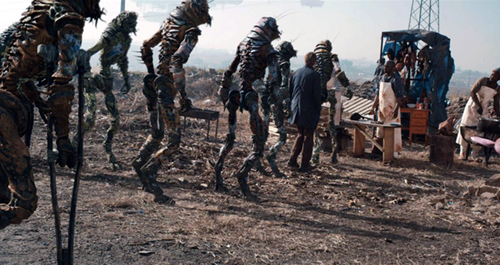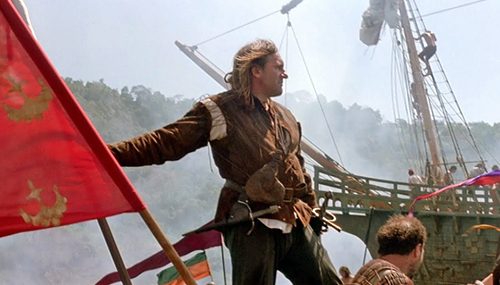
Moby Dick, by Herman Melville (1851), is arguably one of the greatest works in literature, and the subject of many critical studies.
One of the clearest interpretations* I’ve found is that Captain Ahab represents the will to dominate the world (above all other considerations), while the white whale represents unpredictable Life.

Captain Ahab (Gregory Peck) dies plunging his harpoon into the white whale. Ahab didn’t care about his ship staying sound or the lives of his crew; he only desires revenge. (Does this remind you of a presidential candidate whose name begins with a T?)
Stories in which the creatures of the ocean fight back against humanity are also found among the first science-fiction tales.
In 1870, French author Jules Verne (1828-1905) wrote Twenty Thousand Leagues Under the Sea, in which giant squid capsize ships.
H.G. Wells (1866-1946) wrote the short story “The Sea-Raiders” (1896), about large predatory squid that creep ashore to devour human beings.
In 1936, Karel Čapek (1890-1938) wrote War with the Newts, a novel about intelligent salamanders who win primacy over the earth.
The Kraken Wakes, by John Wyndham (1953), is the story of entities from beneath the oceans attacking coastal towns, eliminating the glaciers, and sinking vessels.
In Frank Schätzing’s The Swarm (2015), a team of marine biologists are able to communicate with an amoeba-like intelligence that is attacking humankind, and has lived in the oceans for millions of years.
This memorandum compares the last three novels in the above list.
War with the Newts begins with a Czech seaman Van Toch “discovering” intelligent newts off the coast of Sumatra.
Captain Van Toch finds that the nearly human-sized black salamanders are “teachable” and willing to bring him precious pearls in exchange for human-made tools.
He travels back to Czechia to persuade a businessman (Mr. Bondy) to fund money-making schemes that use the newts.
For the first few years, their company just uses the newts to gather pearls.
(However, that industry merely reaps a 30% profit.)
Unsatisfied with those numbers, the company begins to use the newts for elaborate hydro-engineering projects.
During the next few years, humans become ever more dependent on the newts: as a free labor source, and as consumers for human goods.
Wyndham’s The Kraken Wakes is told from the viewpoint of a married couple (Phyllis and Mike Watson) who are science writers for a British competitor to the BBC.
Another main character is a scientist named Alastair Bocker.
At first, Dr. Bocker believes that humankind can coexist with the beings from the deep, but he later realizes that war is necessary.
The mysterious entities begin to sink ships, and the observation chambers sent to investigate them.
Then, they send gigantic jellyfish-like beings to carry off humans, injuring those that they don’t absorb.
Eventually, the creatures melt the icecaps causing the sea level to rise, so that the earth population is reduced by at least four-fifths.
In Frank Schätzing’s The Swarm, marine biologists gradually begin to understand that attacks by sea creatures, worms that destabilize the continental shelf, lobsters that spread poison, and swarms of white eyeless crabs are all a connected strategy.
They’re able to communicate with the amoeba-like creatures (controlled by a collective intelligence, the Yrr) that attacked humanity.
The novel concludes with a seeming truce between humankind and the newly-discovered marine life-form.
Čapek’s War with the Newts deals with humanity becoming dependent on sentient beings that it considers “inferior.”
However, the “subservient” amphibians become the primary power on the planet, as they remake the globe to match their own needs.
In The Kraken Wakes, an intelligence comes from the stars, and proceeds to remolding the earth as its’ new watery habitat.
(In both novels, the battle isn’t so much a war against humankind, as gentrification.)
In The Swarm, the goal of the “hive mind” may be to increase ocean area, but its’ other goal is likely to stop humanity from harming the ocean ecosystems.

Book cover of Out of the Deeps, the American (heavily-edited and shortened by one chapter) version of The Kraken Wakes.
Motivations aside, the actions of the creatures are similar.
The newts create earthquakes which result in tidal waves, causing great loss of human life, and many more livable shorelines for the salamanders.
The alien creatures, in The Kraken Wakes, melt the polar ice caps raising the sea level by 120 feet, thereby killing and displacing millions of humans.
In Frank Schätzing’s The Swarm, worms (created by the amoeba-like Yrr) destabilize the continental shelf, causing a massive tsunami, again killing millions.
One quality that the three novels share with Moby Dick is a dark view of human behavior.
In one segment of Čapek’s The War with the Newts, a German newspaper proposes that “because of its German environment that this [the German] newt had developed into a different and superior sub-species, indisputably above the level of any other salamander.”
The Kraken Wakes also points out human defects: the ridiculous infighting as human governments drop nuclear bombs willy-nilly, blame each other, and fail to cooperate against the deep-sea menace.
The Swarm finds comic qualities in the grotesque, nativist belief systems of U.S. government officials.
All three of the science-fiction novels deal to some extent with religion.
In War with the Newts, humankind’s cruelty to sentient creatures is on constant display.
(American Black ministers are among the few that show any compassion toward the enslaved newts.)
In The Kraken Wakes, Mike Watson (speaking of humanity and the creatures in the Deep) tells his wife: “We can’t both inherit the earth.”
In The Swarm, religious groups are thrown into chaos by the concept that humans aren’t the primary life-form on the planet.
(In the epilogue, a Catholic bishop sprinkles “the waves with holy water and ordering the devils to depart.”)
The Swarm is more driven by ideas on ecology than either War with the Newts or The Kraken Wakes.
In the earlier novels, the salamanders and the alien entities (that arrive on earth via fireballs) wish to remake the earth, to make it a better home for their species.
However, the hive mind in The Swarm—by sinking and disabling ships, disrupting deep sea cables, and starting epidemics—seems set on saving the marine ecosystem from humanity.
Only when the Yrr realizes that it may have some commonality with humankind, does it stop its’ onslaught.
Although many passages in the Bible preach that humanity should live peacefully with nature, people seem most impressed by the line in Genesis 1:26 about humankind having “dominion.”
Most ignore Genesis 9:1-19 in which Noah promises God that he, and his progeny, will become good stewards for “every beast of the earth.”
U.S. history shows that although the first stewards of the North American continent—the 600 Native American tribes—wanted to live in harmony with nature, the conquering (European Christian) worldview was to use the earth as a wealth source: killing beavers and bison to extinction, searching for gold and other minerals, creating havoc in ecosystems.
According to an article in Hakai (hakaimagazine.com), and reprinted in Smithsonian Magazine, humans “kill, collect or otherwise use about 15,000 vertebrate species, mostly for nonfood reasons.”
According to Dr. Andrea Reid (a scientist quoted in *”Humans Take Out More Wild Species Than Any Other Predator on Earth”) “if we want wild species—fish and beyond—to survive, we need to reframe our relationship with them, perhaps from predator to steward.”
*War in Melville’s Imagination, by Joyce Sparer Adler, The Gotham Library, 1981, pages 55-78.






























